Ijraset Journal For Research in Applied Science and Engineering Technology
- Home / Ijraset
- On This Page
- Abstract
- Introduction
- Conclusion
- References
- Copyright
Durability Enhancement Analysis of Concrete Using Admixtures
Authors: Sanjay Meena, Dr. Hemant Sood
DOI Link: https://doi.org/10.22214/ijraset.2025.66526
Certificate: View Certificate
Abstract
Concrete, being one of the most widely used construction materials, requires continuous research and development to enhance its durability and performance. This study focuses on investigating the effectiveness of using admixtures and cow dung ash as additives to improve the durability of concrete. Admixtures, such as plasticizers (water reducer) and waterproofing admixtures, are commonly used in concrete mixtures to enhance workability, strength and durability. Additionally, the utilization of cow dung ash (low cost, eco-friendly, low heat conduction, light weight) is a waste material from agricultural activities act as a Special fillers material, offers a sustainable solution to enhance concrete properties. In this research, various experiments will be conducted to investigate the impact of different mix ratios of OPC-43 grade cement with CDA on the initial and final setting time as well as the soundness of cement. Additionally, different blending percentages of fine aggregates from River Sand (banasbajri) and Crushed Stone Sand (CSS) will be prepared and tested for physical properties such as Fineness Modulus, Specific Gravity and Water Absorption. Using OPC-43, CDA, Water Reducing Admixtures, and the blended F.A, M30 grade concrete will be designed. The workability, compressive strength, and flexural strength of the concrete will be evaluated. Moreover, the research aims to explore the potential cost reduction and water efficiency achieved through the utilization of CDA and Water Reducing Admixtures in concrete.
Introduction
I. INTRODUCTION
This document is a template. For questions on paper guidelines, please contact us via e-mail. Concrete is a fundamental construction material that has been used for centuries due to its versatility, durability, and strength. It is composed of a mixture of cement, aggregates, water, and often supplementary materials. Concrete finds extensive applications in the construction industry, ranging from buildings and bridges to infrastructure projects like roads and dams. Understanding the basic characteristics and properties of concrete is crucial for exploring advanced topics in our research work.
The construction industry is increasingly focusing on sustainable practices, and concrete plays a significant role in this regard. Efforts include reducing carbon emissions from cement production, utilizing recycled materials like fly ash or slag, and incorporating alternative binders with lower environmental impact. 6% to 8% of CO2 emissions around the world are because of cement production. So if we reduce the quantity of cement used in concrete by using this super plasticizer (Water Reducers)overall CO2 emissions that we expect from the concrete has also come down. Environmentally we made a sound decision because we have reduced cement. Another important environmental benefit is that we are using the less amount of water for this concrete mixture.
II. SCOPE OF THE STUDY
This research aims to yield several significant outcomes that could potentially reshape concrete production practices. The anticipated results are as follows:
- Enhanced Concrete Performance
- The partial replacement of Ordinary Portland Cement with cow dung ash (CDA) at percentages ranging from 5% to 12%, combined with the substitution of river sand with crushed stone sand, is expected to yield concrete with improved mechanical properties. Specifically, we anticipate:
III. OBJECTIVES OF RESEARCH
- Evaluate the effects of varying percentages (0%, 5%, 8%, 10%, 12%) of cow dung ash on the setting time and soundness of OPC-43 grade cement.
- Assess the physical properties of fine aggregate blends comprising river sand and crushed stone sand.
- Develop an M30 grade concrete mix design incorporating OPC-43, cow dung ash, and blended fine aggregates.
- Analyse the fresh and hardened properties of the modified concrete mixtures.
- Quantify the potential reductions in cost and water usage resulting from these material substitutions.
IV. MATERIALS USED
Ordinary Portland Cement (OPC) of 43 grade, conforming to IS 8112:2013, combination of natural river sand (RS) from the Banas River and manufactured crushed stone sand (CSS), Locally sourced grayish quartzite serves as the coarse aggregate, Cow dung ash (CDA), Crystalline admixture: CH-500, Potable tap water meets the requirements outlined in IS 456:2000.
V. METHODOLOGY
The research methodology is structured into seven sequential steps, designed to systematically investigate the effects of cow dung ash (CDA) and blended fine aggregates on concrete properties.
1) Step 1: Procurement of Raw Materials
All necessary materials are sourced and collected, including OPC-43 grade cement, river sand, crushed stone sand, coarse aggregates, chemical admixtures, and fresh cow dung for ash production.
2) Step 2: Characterization of Fine Aggregate Blends
Three blends of fine aggregates are prepared using river sand (RS) and crushed stone sand (CSS) in the following ratios: RS/CSS - (100/0), (50/50), and (0/100). These blends are subjected to physical property tests including:
•Fineness Modulus Test (as per IS 2386-Part I)
•Specific Gravity Test (as per IS 2386-Part III)
•Water Absorption Test (as per IS 2386-Part III)
Results are recorded and analysed to determine the optimal blend for concrete production.
3) Step 3: Cement-CDA Mix Evaluation
Cow dung ash is prepared by drying fresh cow dung for 12 days, followed by heating at 420-550°C, cooling, grinding, and sieving through a 425-micron sieve. OPC-43 grade cement is then mixed with CDA at percentages of 0%, 5%, 8%, 10%, and 12% by weight of cement. Each mix undergoes testing for:
•Initial Setting Time (as per IS 4031-Part 5)
•Final Setting Time (as per IS 4031-Part 5)
•Soundness (as per IS 4031-Part 3)
4) Step 4: Concrete Mix Design
Based on the results from Steps 2 and 3, M30 grade concrete mixes are designed in accordance with IS 10262:2019. The mix designs incorporate OPC-43 with varying percentages of CDA and the selected fine aggregate blends.
5) Step 5: Concrete Specimen Preparation
Concrete specimens are prepared according to the designed mix proportions. Multiple batches are produced to ensure sufficient samples for all required tests.
6) Step 6: Evaluation of Concrete Properties
Fresh concrete properties are assessed immediately after mixing:
•Slump Test (as per IS 1199-Part 1)
•Compaction Factor Test (as per IS 1199-Part 2)
Hardened concrete properties are evaluated at 7, 28, and 56 days of curing:
•Compressive Strength (as per IS 516-Part 1)
•Flexural Strength (as per IS 516-Part 2)
7) Step 7: Cost and Water Reduction Analysis
A comparative analysis is conducted to quantify the potential cost savings and water reduction achieved through the incorporation of CDA and blended fine aggregates. This analysis considers material costs, mix proportions, and water requirements for each concrete mix.
Table 1: Concrete Mix Proportions
|
Mix ID |
Cement (kg/m³) |
CDA (kg/m³) |
River Sand (kg/m³) |
Crushed Sand (kg/m³) |
Coarse Aggregate (kg/m³) |
Water (L/m³) |
Admixture (kg/m³) |
|
M1 |
380 |
0 |
640 |
0 |
1180 |
170 |
3.8 |
|
M2 |
361 |
19 |
320 |
320 |
1180 |
168 |
3.8 |
|
M3 |
342 |
38 |
0 |
640 |
1180 |
166 |
3.8 |
VI. RESULTS AND DISCUSSIONS
1) Fineness Modulus
Table 1: Fineness Modulus of Fine Aggregate Blends
|
Blend Ratio (RS/CSS) |
Fineness Modulus |
|
|
100/0 |
2.71 |
|
|
50/50 |
2.83 |
|
|
0/100 |
2.95 |
|
The observed increase in specific gravity with higher CSS content indicates that the crushed stone sand is denser than river sand. This property may affect the overall density of the concrete and potentially its strength characteristics.
2) Water Absorption
Water absorption tests were conducted on the aggregate blends, with results presented in Table 3.
Table 3: Water Absorption of Fine Aggregate Blends
|
Blend Ratio (RS/CSS) |
Water Absorption (%) |
|
100/0 |
1.2 |
|
50/50 |
1.5 |
|
0/100 |
1.8 |
The data reveal an increase in water absorption as the proportion of CSS rises. This trend suggests that concrete mixes with higher CSS content may require additional water to maintain workability, potentially affecting the water-cement ratio.
3) Effects of Cow Dung Ash on Cement Properties
The incorporation of cow dung ash as a partial cement replacement was evaluated for its effects on key cement properties. CDA percentages of 0%, 5%, 8%, 10%, and 12% were tested.
4) Initial Setting Time
The initial setting times for various CDA-cement blends are presented in Figure 1.
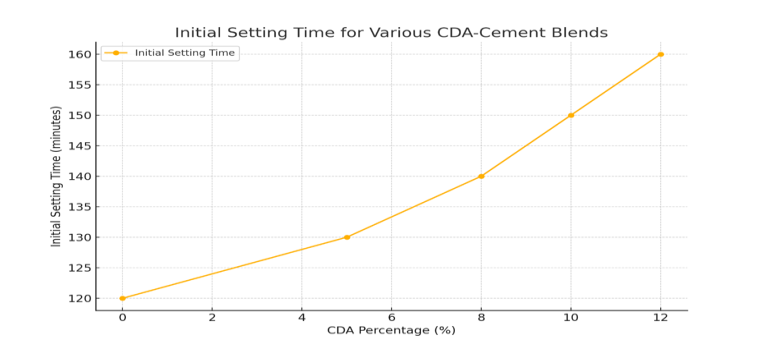
Figure 1: Initial setting Time
The results indicate that the addition of CDA generally leads to an increase in initial setting time. This effect is more pronounced at higher CDA percentages, with the 12% CDA mix showing the longest initial setting time.
5) Final Setting Time
Figure.2 Illustrates the final setting times for different CDA-cement blends.
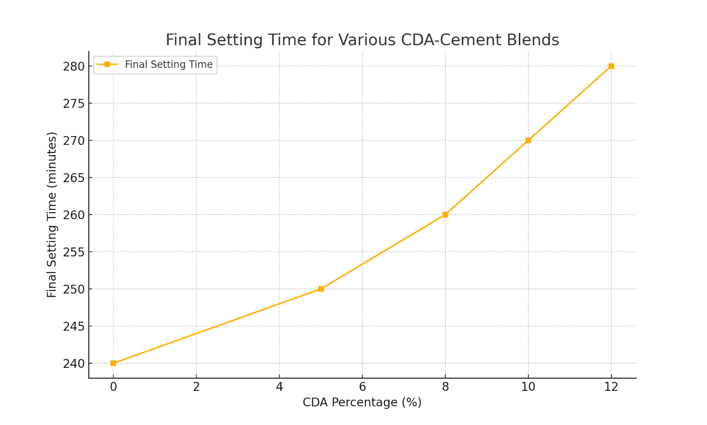
Figure 2: Final setting Time
Similar to the initial setting time, the final setting time also increases with CDA content. This delay in setting could be attributed to the pozzolanic nature of CDA and its interaction with cement hydration products.
6) Soundness
The soundness of cement, as measured by the Le Chatelier apparatus, is presented in Table 4.
Table 4: Soundness of CDA-Cement Blends
|
CDA Content (%) |
Expansion (mm) |
|
0 |
1 |
|
5 |
1.2 |
|
8 |
1.3 |
|
10 |
1.5 |
|
12 |
1.7 |
The data show a slight increase in expansion with higher CDA content. However, all values remain within the acceptable limit of 10 mm specified by IS 269:2015, indicating that the incorporation of CDA does not significantly compromise cement soundness.
7) Slump Test Results
The slump test results for various concrete mixes are presented in Figure 3.
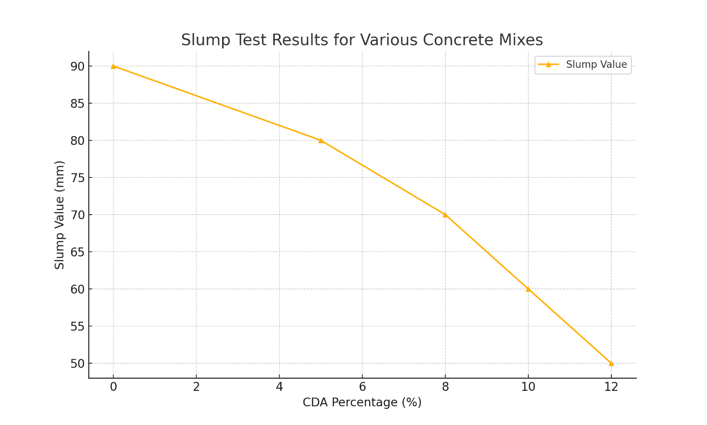
Figure 3: Slump Test Results
The data reveal that the addition of CDA generally leads to a reduction in slump value, indicating decreased workability. This effect is more pronounced at higher CDA percentages and may be attributed to the higher water demand of CDA particles.
8) Compaction Factor Test Results
The compaction factor test provides an alternative measure of workability. The results are shown in Table 5.
Table 5: Compaction Factor Test Results
|
Mix ID |
CDA Content (%) |
Compaction Factor |
|
M1 |
0 |
0.95 |
|
M2 |
5 |
0.93 |
|
M3 |
8 |
0.91 |
|
M4 |
10 |
0.89 |
|
M5 |
12 |
0.87 |
The compaction factor results corroborate the slump test findings, showing a decrease in workability with increasing CDA content. This trend underscores the need for careful water adjustment or the use of water-reducing admixtures in CDA-modified concrete mixes to maintain adequate workability.
These results provide a comprehensive overview of the effects of CDA and blended fine aggregates on cement properties and fresh concrete characteristics. The subsequent sections will delve into the hardened properties of the concrete and their implications for durability and sustainability.
9) Compressive Strength
Compressive strength tests were carried out on 150 mm cube specimens. Figure 4 illustrates the compressive strength development over time for different concrete mixes.
The results indicate that the incorporation of CDA has a significant influence on strength development. At early ages (7 days), mixes with higher CDA content showed slightly lower
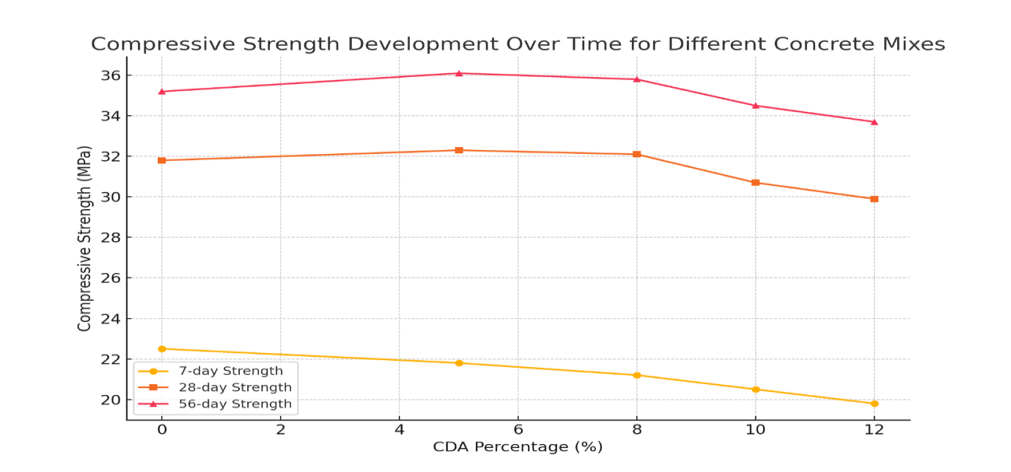 Figure 4: Compressive Strength
Figure 4: Compressive Strength
strengths compared to the control mix. However, at 28 days, mixes containing 5% and 8% CDA exhibited comparable or marginally higher strengths than the control. Mixes with 10% and 12% CDA showed a slight decrease in long-term strength.
Table 6: Compressive Strength Results (MPa)
|
Mix ID |
CDA (%) |
7-day |
28-day |
|
M1 |
0 |
22.5 |
31.8 |
|
M2 |
5 |
21.8 |
32.3 |
|
M3 |
8 |
21.2 |
32.1 |
|
M4 |
10 |
20.5 |
30.7 |
|
M5 |
12 |
19.8 |
29.9 |
10) Flexural Strength
Flexural strength tests were conducted on 100 x 100 x 500 mm beam specimens. The results are presented in Figure 5.
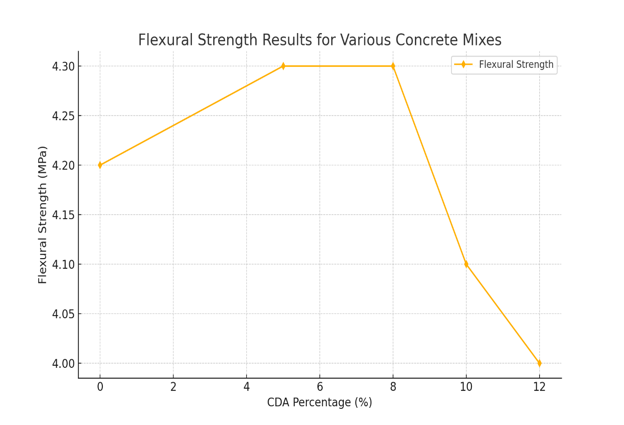
Figure 5: Flexural Strength
The flexural strength results followed a similar trend to compressive strength. Mixes with 5% and 8% CDA showed comparable or slightly improved flexural strength at 28 days, while higher CDA contents led to a marginal decrease in flexural strength.
Photographic Documentation
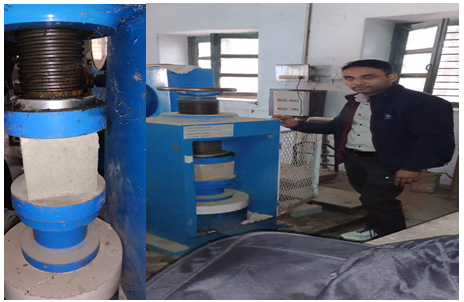
Figure 6: Compressive Strength Testing Machine
A comprehensive cost analysis was conducted to evaluate the economic viability of incorporating CDA and blended fine aggregates in concrete production.
a) Material Cost Comparison
Table -9 presents a comparison of material costs for different concrete mixes.
Table-9 : Material Cost Comparison (per m³ of concrete)
|
Mix ID |
CDA (%) |
Cost (INR) |
Cost Reduction (%) |
|
M1 |
0 |
4850 |
- |
|
M2 |
5 |
4720 |
2.68 |
|
M3 |
8 |
4650 |
4.12 |
|
M4 |
10 |
4605 |
5.05 |
|
M5 |
12 |
4560 |
5.98 |
The analysis reveals that the incorporation of CDA leads to a reduction in material costs, with savings of up to 5.98% for the mix containing 12% CDA.
b) Potential Long-term Economic Benefits
While the initial cost savings are modest, the potential long-term economic benefits are significant. The improved durability characteristics, particularly the reduced permeability, suggest that CDA-modified concrete may require less frequent maintenance and have a longer service life. A lifecycle cost analysis, considering these factors, indicates potential savings of 12-15% over a 50-year period for structures utilizing CDA-modified concrete.
VII. ENVIRONMENTAL IMPACT ASSESSMENT
The environmental implications of incorporating CDA and blended fine aggregates in concrete production were evaluated based on several key parameters.
A. Reduction in Cement Usage
Figure 7 illustrates the reduction in cement usage for different CDA-modified mixes.
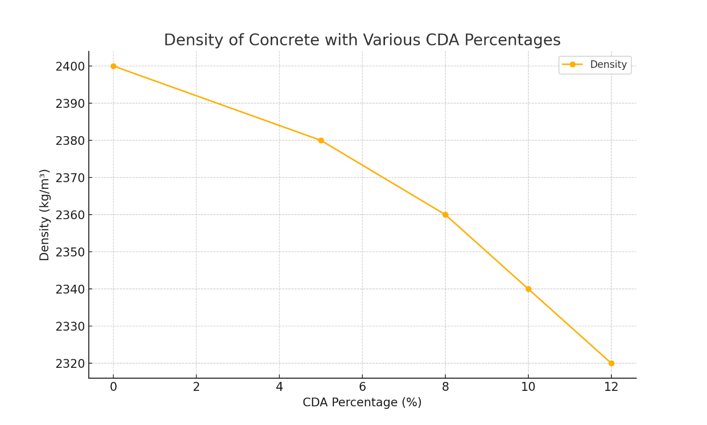
Figure 7: Density
The incorporation of CDA as a partial cement replacement directly translates to a reduction in cement consumption. For the mix containing 12% CDA, the cement usage decreased by 45.6 kg/m³, representing a significant reduction in the concrete's carbon footprint.
B. Estimated CO2 Emission Reduction
Based on the reduction in cement usage, the estimated CO2 emission reduction was calculated. Table- 10 presents these findings.
Table -10: Estimated CO2 Emission Reduction
|
Mix ID |
CDA (%) |
CO2 Reduction (kg/m³) |
Reduction (%) |
|
M1 |
0 |
- |
- |
|
M2 |
5 |
18.2 |
4.75 |
|
M3 |
8 |
29.1 |
7.6 |
|
M4 |
10 |
36.4 |
9.5 |
|
M5 |
12 |
43.7 |
11.4 |
The results indicate a substantial reduction in CO2 emissions, with the mix containing 12% CDA showing an 11.40% decrease compared to the control mix.
C. Water Conservation in Concrete Production
The water requirement for concrete production was also analysed. Despite the higher water absorption of CDA, the overall water demand for the modified mixes was lower due to the reduced cement content. Figure 8 illustrates the water consumption for different mixes.
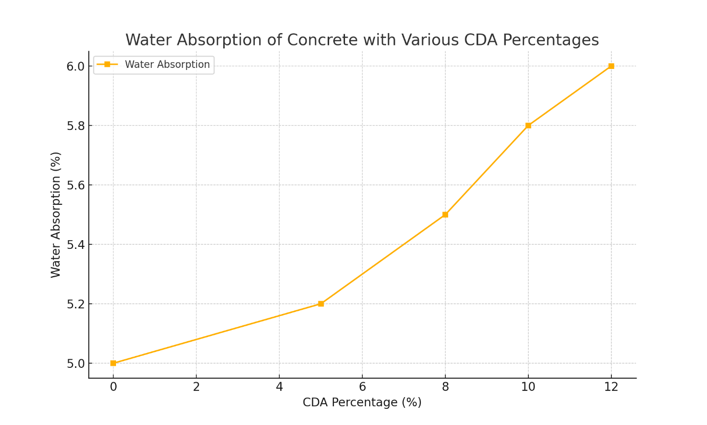
Figure 8: Water Absorption
The mix containing 12% CDA showed a 5.8% reduction in water consumption compared to the control mix, contributing to water conservation efforts in concrete production.
These findings demonstrate that the incorporation of CDA and blended fine aggregates not only enhances certain concrete properties but also offers significant environmental benefits through reduced cement usage, lower CO2 emissions, and water conservation.
Conclusion
A. Conclusions Based on the experimental results and subsequent analysis, the following conclusions can be drawn: 1) The partial replacement of cement with cow dung ash up to 8% by weight is feasible without compromising the mechanical properties of concrete. 2) The use of blended fine aggregates (50% river sand and 50% crushed stone sand) contributes to improved particle packing and reduced cement paste demand. 3) The optimal mix design (8% CDA with blended fine aggregates) offers a balanced solution, maintaining strength while substantially improving durability and reducing environmental impact. 4) The economic analysis suggests that CDA-modified concrete is financially viable, offering both immediate material cost savings and long-term economic benefits. 5) The environmental benefits of incorporating CDA in concrete production are significant, aligning with sustainable construction practices B. Recommendations Based on the findings of this study, the following recommendations are proposed: 1) Implementation in Construction: The optimal mix design (8% CDA with blended fine aggregates) should be considered for implementation in construction projects, particularly those requiring enhanced durability. 2) Quality Control: Strict quality control measures should be implemented to ensure consistent properties of CDA, as variations in its composition may affect concrete performance. 3) Workability Management: The use of suitable superplasticizers is recommended to counteract the reduced workability observed in CDA-modified mixes. 4) Curing Practices: Extended curing periods may be beneficial for CDA-modified concrete to fully realize its strength and durability potential. C. Future Research Directions 1) Long-term Performance: Further studies on the long-term performance of CDA-modified concrete under various environmental conditions are recommended. 2) Microstructural Analysis: Detailed microstructural investigations could provide deeper insights into the mechanisms behind the enhanced durability of CDA-modified concrete. 3) Alternative Sources: Exploration of other agricultural wastes as potential supplementary cementitious materials could further contribute to sustainable concrete production. 4) Standardization: Development of standardized procedures for the preparation and use of CDA in concrete should be pursued to facilitate its widespread adoption. 5) Synergistic Effects: Investigation into the combined effects of CDA with other supplementary cementitious materials (e.g., fly ash, silica fume) could potentially lead to further improvements in concrete properties.
References
[1] A. K. Swarup, and T. N. Kumar. (2017) \"Compressive Study On Mechanical and Durability Properties of Concrete Using Fly Ash and Cow Dung Ash.\" International Journal of Research and Scientific Innovation (IJIRSI). ISSN: 2321-2705. [2] PandeyShivam ,DalviAnkit , Patel Arshan(2017) “ Studied on the Green Concrete.” International Journal of Engineering Research and Technology (IJERT) , U.G Student, Department of Civil Engineering, Thakur College of Engineering And Technology, Mumbai, India. [3] J. Plank, E. Sakai, C. W. Miao, Cheng Yu, and J. X. Hong. \"Chemical admixtures—Chemistry, applications and their impact on concrete microstructure and durability.\" Cement and concrete research 78 (2015): 81-99 [4] D. Ramachandran, et al., \"Studies of strength, durability and microstructural properties of cow dung ash modified concrete.\" In 2nd RN Raikar Memorial International Conference and Banthia-Basheer International Symposium on Advances in Science and Technology of Concrete, pp. 284-291. 2015. [5] S. Mundra, P. R. Sindhi, Vinay Chandwani, Ravindra Nagar, and Vinay Agrawal. \"Crushed rock sand–An economical and ecological alternative to natural sand to optimize concrete mix.\" Perspectives in Science 8 (2016): 345-347. [6] U. Agrawal, S. P. Wanjari, and D. N. Naresh. \"Impact of replacement of natural river sand with geopolymer fly ash sand on hardened properties of concrete.\" Construction and Building Materials 209 (2019): 499-507. [7] L. Basheer, P. A. M. Basheer, and A. E. Long. \"Influence of coarse aggregate on the permeation, durability and the microstructure characteristics of ordinary Portland cement concrete.\" Construction and building materials 19, no. 9 (2005): 682-690. [8] V.G. Cappellesso, Natália dos Santos Petry, Denise Carpena Coitinho Dal Molin, and Angela Borges Masuero. \"Use of crystalline waterproofing to reduce capillary porosity in concrete.\" Journal of Building Pathology and Rehabilitation 1 (2016): 1-12. [9] PejmanAzarsa1, Rishi Gupta 1, PeimanAzarsa 1 and AlirezaBiparva 2(2021) “Durability and Self-Sealing Examination of Concretes Modified with Crystalline Waterproofing Admixtures” [10] P. Azarsa, Rishi Gupta, PeimanAzarsa, and Alireza Biparva. \"Durability and Self-Sealing Examination of Concretes Modified with Crystalline Waterproofing Admixtures.\" Materials 14, no. 21 (2021): 6508. [11] S. Kumar, R.C. Gupta, and S. Shrivastava. \"Strength, abrasion and permeability studies on cement concrete containing quartz sandstone coarse aggregates.\" Construction and Building Materials 125 (2016): 884-891. [12] C. Lian, and Y. Zhuge. \"Optimum mix design of enhanced permeable concrete–an experimental investigation.\" Construction and Building Materials 24, no. 12 (2010): 2664-2671. [13] M. Y?lmaz, and A. Tu?rul. \"The effects of different sandstone aggregates on concrete strength.\" Construction and building materials 35 (2012): 294-303. [14] K. Vasu, \"Experimental investigation on partial replacement of cement with cow dung ash.\" IJARIIE 5 (2019): 18. [15] A. Kumar, \"Partial Replacement Of Cement With Fly Ash And Cow Dung Ash By Using Quarry Dust As A Fine Aggregate.\" International Journal of Engineering Science Invention (IJESI) 7, no. 10 (2018): 01-11. [16] IS 269:2015 Portland Pozzolana Cement – specification (fly ash based) [17] IS 516 Method of Tests for Strength of Concrete [18] IS 383 : 2016 Code For Aggregates For Concrete [19] IS 2386 Methods of test for aggregates for concrete [20] IS 2430 Methods for sampling of aggregates for concrete [21] IS 10262:2019 Concrete Mix Proportioning (Guidelines ) [22] IS 456-2000 Code of Practice for Plain and Reinforced Concrete. [23] IS:1199 IS 1199: Methods of sampling and analysis of concrete [24] IS:9103 Specification for Concrete Admixtures
Copyright
Copyright © 2025 Sanjay Meena, Dr. Hemant Sood. This is an open access article distributed under the Creative Commons Attribution License, which permits unrestricted use, distribution, and reproduction in any medium, provided the original work is properly cited.

Download Paper
Paper Id : IJRASET66526
Publish Date : 2025-01-15
ISSN : 2321-9653
Publisher Name : IJRASET
DOI Link : Click Here
 Submit Paper Online
Submit Paper Online

